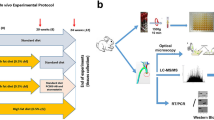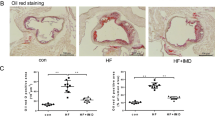Abstract
Oxidative stress, an inducer of apoptosis, plays a critical role in ischemia/reperfusion injury and atherosclerosis. We previously identified an apoptosis-inducing ligand, the post-translationally modified secreted form of eukaryotic translation initiation factor 5A (eIF5A), ‘oxidative stress-responsive apoptosis-inducing protein’ (ORAIP). In this study, we investigated the role of ORAIP in patients with heterozygous familial hypercholesterolemia (HeFH), a leading cause of premature cardiovascular disease. We analyzed plasma ORAIP and oxidized low-density lipoprotein (oxLDL) levels in 60 patients with HeFH (60% male, 57.0 ± 13.6 years of age) and 20 patients with LDL-C hypercholesterolemia (DL, 85% male, 64.1 ± 13.3 years of age). The coronary artery atherosclerosis from the patients with HeFH who had a coronary artery bypass graft was investigated by double immunostaining. The plasma ORAIP levels in the patients with HeFH were significantly elevated compared to those in the patients with DL (73.5 ± 46.0 vs. 48.3 ± 21.4 ng/mL, p = 0.0277). The plasma oxLDL levels in HeFH patients were also elevated (156.8 ± 65.2 vs. 123.7 ± 46.6 mg/dL, p = 0.0461) compared to those in DL patients and correlated with maxLDL-C levels (R = 0.4454, p = 0.00648). Double-immunostaining of ORAIP and oxLDL in the coronary artery from patients with HeFH who had a coronary artery bypass graft showed that ORAIP and oxLDL were colocalized with apoptotic vascular smooth muscle cells in the atherosclerotic plaque. ORAIP plays a role in the development of oxidative stress-induced atherosclerosis and may be an important therapeutic target for plaque rupture in patients with HeFH.




Similar content being viewed by others
References
Tangvarasittichai S (2015) Oxidative stress, insulin resistance, dyslipidemia and type 2 diabetes mellitus. World J Diabetes 6:456–480
Ansley DM, Wang B (2013) Oxidative stress and myocardial injury in the diabetic heart. J Pathol 229:232–241
Gonzalez J, Valls N, Brito R, Rodrigo R (2014) Essential hypertension and oxidative stress: new insights. World J Cardiol 6:353–366
Csont T, Bereczki E, Bencsik P, Fodor G, Gorbe A, Zvara A, Csonka C, Puskas LG, Santha M, Ferdinandy P (2007) Hypercholesterolemia increases myocardial oxidative and nitrosative stress thereby leading to cardiac dysfunction in apoB-100 transgenic mice. Cardiovasc Res 76:100–109
Nielsen MH, Irvine H, Vedel S, Raungaard B, Beck-Nielsen H, Handberg A (2016) The impact of lipoprotein-associated oxidative stress on cell-specific microvesicle release in patients with familial hypercholesterolemia. Oxid Med Cell Longev 2016:2492858
Pignatelli P, Sanguigni V, Lenti L, Loffredo L, Carnevale R, Sorge R, Violi F (2007) Oxidative stress-mediated platelet CD40 ligand upregulation in patients with hypercholesterolemia: effect of atorvastatin. J Thromb Haemost 5:1170–1178
Gohbara M, Iwahashi N, Nakahashi H, Kataoka S, Takahashi H, Kirigaya J, Minamimoto Y, Akiyama E, Okada K, Matsuzawa Y, Konishi M, Maejima N, Hibi K, Kosuge M, Ebina T, Sugano T, Ishikawa T, Tamura K, Kimura K (2021) Clinical impact of admission urinary 8-hydroxydeoxyguanosine level for predicting cardiovascular mortality in patients with acute coronary syndrome. Heart Vessels 36:38–47
Huang YC, Chin CC, Chen CS, Shindel AW, Ho DR, Lin CS, Shi CS (2015) Chronic cigarette smoking impairs erectile function through increased oxidative stress and apoptosis, decreased nNOS, endothelial and smooth muscle contents in a rat model. PLoS ONE 10:e0140728
Mesaros C, Arora JS, Wholer A, Vachani A, Blair IA (2012) 8-Oxo-2’-deoxyguanosine as a biomarker of tobacco-smoking-induced oxidative stress. Free Radic Biol Med 53:610–617
Bonomini F, Tengattini S, Fabiano A, Bianchi R, Rezzani R (2008) Atherosclerosis and oxidative stress. Histol Histopathol 23:381–390
Madamanchi NR, Vendrov A, Runge MS (2005) Oxidative stress and vascular disease. Arterioscler Thromb Vasc Biol 25:29–38
Harrison D, Griendling KK, Landmesser U, Hornig B, Drexler H (2003) Role of oxidative stress in atherosclerosis. Am J Cardiol 91:7A-11A
Vogiatzi G, Tousoulis D, Stefanadis C (2009) The role of oxidative stress in atherosclerosis. Hellenic J Cardiol 50:402–409
Seko Y, Fujimura T, Yao T, Taka H, Mineki R, Okumura K, Murayama K (2015) Secreted tyrosine sulfated-eIF5A mediates oxidative stress-induced apoptosis. Sci Rep 5:13737
Yao T, Fujimura T, Murayama K, Okumura K, Seko Y (2017) Oxidative stress-responsive apoptosis inducing protein (ORAIP) plays a critical role in high glucose-induced apoptosis in rat cardiac myocytes and murine pancreatic β-cells. Cells 6:35
Kishimoto M, Suenaga J, Takase H, Araki K, Yao T, Fujimura T, Murayama K, Okumura K, Ueno R, Shimizu N, Kawahara N, Yamamoto T, Seko Y (2019) Oxidative stress-responsive apoptosis inducing protein (ORAIP) plays a critical role in cerebral ischemia/reperfusion injury. Sci Rep 9:13512
Yao T, Tanaka K, Fujimura T, Murayama K, Fukuda S, Okumura K, Seko Y (2016) Plasma levels of oxidative stress-responsive apoptosis inducing protein (ORAIP) in patients with atrial fibrillation. Int J Cardiol 222:528–530
Tanaka K, Yao T, Sato K, Okumura K, Seko Y (2017) Oxidative stress-responsive apoptosis inducing protein (ORAIP) plays a critical role in the cardiac injury in patients with heart failure. Ann Pharmacol Pharm 2:1100
Gidding SS, Champagne MA, de Ferranti SD, Defesche J, Ito MK, Knowles JW, McCrindle B, Raal F, Rader D, Santos RD, Lopes-Virella M, Watts GF, Wierzbicki AS, American Heart Association Atherosclerosis H, Obesity in Young Committee of Council on Cardiovascular Disease in Young CoC, Stroke Nursing CoFG, Translational B, Council on L, Cardiometabolic H (2015) The agenda for familial hypercholesterolemia: a scientific statement from the American Heart Association. Circulation 132:2167–2192
Nordestgaard BG, Chapman MJ, Humphries SE, Ginsberg HN, Masana L, Descamps OS, Wiklund O, Hegele RA, Raal FJ, Defesche JC, Wiegman A, Santos RD, Watts GF, Parhofer KG, Hovingh GK, Kovanen PT, Boileau C, Averna M, Boren J, Bruckert E, Catapano AL, Kuivenhoven JA, Pajukanta P, Ray K, Stalenhoef AF, Stroes E, Taskinen MR, Tybjaerg-Hansen A, European Atherosclerosis Society Consensus P (2013) Familial hypercholesterolaemia is underdiagnosed and undertreated in the general population: guidance for clinicians to prevent coronary heart disease: consensus statement of the European Atherosclerosis Society. Eur Heart J 34:3478–3490a
Mata P, Alonso R, Perez de Isla L (2018) Atherosclerotic cardiovascular disease risk assessment in familial hypercholesterolemia: does one size fit all? Curr Opin Lipidol 29:445–452
Teramoto T, Sasaki J, Ishibashi S, Birou S, Daida H, Dohi S, Egusa G, Hiro T, Hirobe K, Iida M, Kihara S, Kinoshita M, Maruyama C, Ohta T, Okamura T, Yamashita S, Yokode M, Yokote K, Harada-Shiba M, Arai H, Bujo H, Nohara A, Ohta T, Oikawa S, Okada T, Wakatsuki A (2014) Familial hypercholesterolemia. J Atheroscler Thromb 21:6–10
Hashimoto T, Minami Y, Asakura K, Katamine M, Kato A, Katsura A, Sato T, Muramatsu Y, Kakizaki R, Fujiyoshi K, Ishida K, Kameda R, Meguro K, Shimohama T, Ako J (2021) Achilles tendon thickening is associated with higher incidence of adverse cardiovascular event in patients with coronary artery disease. Heart Vessels 36:163–169
Niessner A, Sato K, Chaikof EL, Colmegna I, Goronzy JJ, Weyand CM (2006) Pathogen-sensing plasmacytoid dendritic cells stimulate cytotoxic T-cell function in the atherosclerotic plaque through interferon-alpha. Circulation 114:2482–2489
Pryshchep S, Sato K, Goronzy JJ, Weyand CM (2006) T cell recognition and killing of vascular smooth muscle cells in acute coronary syndrome. Circ Res 98:1168–1176
Sato K, Niessner A, Kopecky SL, Frye RL, Goronzy JJ, Weyand CM (2006) TRAIL-expressing T cells induce apoptosis of vascular smooth muscle cells in the atherosclerotic plaque. J Exp Med 203:239–250
Sato K, Nuki T, Gomita K, Weyand CM, Hagiwara N (2010) Statins reduce endothelial cell apoptosis via inhibition of TRAIL expression on activated CD4 T cells in acute coronary syndrome. Atherosclerosis 213:33–39
Daugherty A, Dunn JL, Rateri DL, Heinecke JW (1994) Myeloperoxidase, a catalyst for lipoprotein oxidation, is expressed in human atherosclerotic lesions. J Clin Invest 94:437–444
Newby AC (2016) Metalloproteinase production from macrophages—a perfect storm leading to atherosclerotic plaque rupture and myocardial infarction. Exp Physiol 101:1327–1337
Teng N, Maghzal GJ, Talib J, Rashid I, Lau AK, Stocker R (2017) The roles of myeloperoxidase in coronary artery disease and its potential implication in plaque rupture. Redox Rep 22:51–73
Harada-Shiba M, Arai H, Oikawa S, Ohta T, Okada T, Okamura T, Nohara A, Bujo H, Yokote K, Wakatsuki A, Ishibashi S, Yamashita S (2012) Guidelines for the management of familial hypercholesterolemia. J Atheroscler Thromb 19:1043–1060
Morel DW, Hessler JR, Chisolm GM (1983) Low density lipoprotein cytotoxicity induced by free radical peroxidation of lipid. J Lipid Res 24:1070–1076
Steinbrecher UP, Parthasarathy S, Leake DS, Witztum JL, Steinberg D (1984) Modification of low density lipoprotein by endothelial cells involves lipid peroxidation and degradation of low density lipoprotein phospholipids. Proc Natl Acad Sci USA 81:3883–3887
Steinberg D, Parthasarathy S, Carew TE, Khoo JC, Witztum JL (1989) Beyond cholesterol. Modifications of low-density lipoprotein that increase its atherogenicity. N Engl J Med 320:915–924
Kyaw T, Peter K, Li Y, Tipping P, Toh BH, Bobik A (2017) Cytotoxic lymphocytes and atherosclerosis: significance, mechanisms and therapeutic challenges. Br J Pharmacol 174:3956–3972
Afshar M, Rong J, Zhan Y, Chen HY, Engert JC, Sniderman AD, Larson MG, Vasan RS, Thanassoulis G (2020) Risks of incident cardiovascular disease associated with concomitant elevations in lipoprotein(a) and low-density lipoprotein cholesterol—the framingham heart study. J Am Heart Assoc 9:14711
Suzuki Y, Yao T, Okumura K, Seko Y, Kitano S (2019) Elevation of the vitreous body concentrations of oxidative stress-responsive apoptosis-inducing protein (ORAIP) in proliferative diabetic retinopathy. Graefes Arch Clin Exp Ophthalmol 257:1519–1525
Acknowledgements
K.S. was supported by a Grant-in-Aid for Scientific Research from the Ministry of Education, Culture, Sports, Science and Technology of Japan and a research support grant from Initiative for Realizing Diversity in the Research Environment.
Author information
Authors and Affiliations
Corresponding author
Ethics declarations
Conflict of interest
The authors have no conflicts of interest to disclose.
Additional information
Publisher's Note
Springer Nature remains neutral with regard to jurisdictional claims in published maps and institutional affiliations.
Rights and permissions
About this article
Cite this article
Sato, K., Yao, T., Fujimura, T. et al. Oxidative stress-responsive apoptosis-inducing protein in patients with heterozygous familial hypercholesterolemia. Heart Vessels 36, 1923–1932 (2021). https://doi.org/10.1007/s00380-021-01898-9
Received:
Accepted:
Published:
Issue Date:
DOI: https://doi.org/10.1007/s00380-021-01898-9




